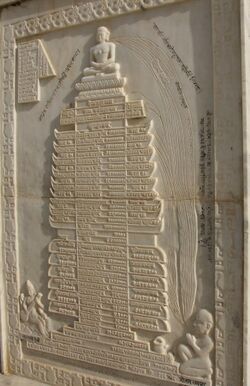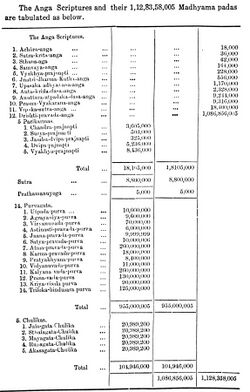Religion:Digambara literature
Agamas are texts of Digambara Jainism based on the discourses of the tirthankara. Pravachanasara, Samaysara, Niyamsara, Pancastikayasara, Ashtapahuda, Kasayapahuda and Shatkhandagama are considered Agamic Texts by Digambaras.
History
Gautamasvami is said to have compiled the most sacred canonical scriptures comprising twelve parts, also referred to as eleven Angas and fourteen Pūrvas, since the twelfth Anga comprises the fourteen Pūrvas. These scriptures are said to have contained the most comprehensive and accurate description of every branch of learning that one needs to know.[1] The knowledge contained in these scriptures was transmitted orally by the teachers to their disciple saints. Agamas were lost during the same famine that the purvas were lost in.[2] Āchārya Bhutabali was the last ascetic who had partial knowledge of the original canon. Later on, some learned Āchāryas started to restore, compile and put into written words the teachings of Lord Mahavira, that were the subject matter of Agamas.[3] Āchārya Dharasena, in first century CE, guided two Āchāryas, Āchārya Pushpadanta and Āchārya Bhutabali, to put these teachings in the written form. The two Āchāryas wrote, on palm leaves, Ṣaṭkhaṅḍāgama- among the oldest known Digambara Jaina texts. This was about 683 years after the nirvana of Mahavira. This set is also called first āgama or Pratham Shrut-Skandh
The Panch Paramāgama (Samaysara, Pravachanasara, Niyamsara, Pancastikayasara and Ashtapahuda) by Acharya Kundakunda which are sourced from both Mahavira and Living God are referred to as the second āgama or Dvitiya Shrut-Skandh.
Angas
The Shruta-Jnana is contained in twelve Angas (lit. limbs). These include, among other things, the rules of conduct for ascetics and the laypeople, as well as the Jain theory of soul, matter and other substances.[4]
Jain literature
Digambaras group texts into four literary categories called 'exposition' (anuyoga).[5] The 'first' (prathma) exposition contains Digambara versions of the Universal History; the 'calculation' (karana) exposition contains works on cosmology; the 'behaviour' (charana) exposition includes texts about proper behaviour for monks and lay people; The 'substance' (dravya) exposition includes texts about ontology of the universe and self.[5]
Importance
For Jains, their scriptures represent the literal words of Mahāvīra and the other fordmakers only to the extent that the Agama is a series of beginning-less, endless and fixed truths, a tradition without any origin, human or divine, which in this world age has been channelled through Sudharma, the last of Mahavira's disciples to survive.[6]
Gallery
Stela depicting Jinvani (Śhrut Jnāna)
Folio from a Kalpa Sūtra (Book of Sacred Precepts), c. AD 1400
See also
Citations
- ↑ Vijay K. Jain 2012, p. xi.
- ↑ Upinder Singh 2016, p. 444.
- ↑ Vijay K. Jain 2012, p. xii.
- ↑ Jaini 1927, pp. 12-14.
- ↑ 5.0 5.1 Dundas 2002, p. 80.
- ↑ Dundas 2002, p. 61.
References
- Cort, John E., ed. (1998), Open Boundaries: Jain Communities and Cultures in Indian History, SUNY Press, ISBN 0-7914-3785-X, https://books.google.com/books?id=yoHfm7BgqTgC
- Cort, John E. (2010), Framing the Jina: Narratives of Icons and Idols in Jain History, Oxford University Press, ISBN 978-0-19-538502-1, https://books.google.com/books?id=MDBpq23-0QoC
- Dundas, Paul (2002), The Jains (Second ed.), London and New York City: Routledge, ISBN 0-415-26605-X, https://books.google.com/books?id=X8iAAgAAQBAJ
- Jain, Champat Rai (1929), Risabha Deva - The Founder of Jainism, Allahabad: The Indian Press Limited, https://archive.org/details/RisabhaDeva-TheFounderOfJainism, "
 This article incorporates text from this source, which is in the public domain."
This article incorporates text from this source, which is in the public domain." - Jain, Vijay K. (2011), Acharya Umasvami's Tattvarthsutra (1st ed.), Uttarakhand: Vikalp Printers, ISBN 81-903639-2-1, https://books.google.com/books?id=zLmx9bvtglkC, "
 This article incorporates text from this source, which is in the public domain."
This article incorporates text from this source, which is in the public domain." - Jain, Vijay K. (2012), Acharya Amritchandra's Purushartha Siddhyupaya: Realization of the Pure Self, With Hindi and English Translation, Vikalp Printers, ISBN 978-81-903639-4-5, https://books.google.com/books?id=4iyUu4Fc2-YC, "
 This article incorporates text from this source, which is in the public domain."
This article incorporates text from this source, which is in the public domain." - Jaini, Jagmandar Lal (1927), Gommatsara Jiva-kanda, https://archive.org/download/sacredbooksofthe029558mbp
- Melton, J. Gordon, ed. (2010), Religions of the World: A Comprehensive Encyclopedia of Beliefs and Practices, One: A-B (Second ed.), ABC-CLIO, ISBN 978-1-59884-204-3, https://books.google.com/books?id=v2yiyLLOj88C
- Shah, Natubhai (2004) [First published in 1998], Jainism: The World of Conquerors, I, Motilal Banarsidass, ISBN 81-208-1938-1, https://books.google.com/books?id=qLNQKGcDIhsC
- Singh, Upinder (2016), A History of Ancient and Early Medieval India: From the Stone Age to the 12th Century, Pearson Education, ISBN 978-93-325-6996-6, https://books.google.com/books?id=Pq2iCwAAQBAJ
Further reading
- Rishabhanatha, in Encyclopaedia Britannica, Editors of the Encyclopaedia Britannica, 2010, https://www.britannica.com/topic/Rishabhanatha
- Dalal, Roshen (2010), Hinduism: An Alphabetical Guide, Penguin Books, ISBN 978-0-14-341421-6, https://books.google.com/books?id=DH0vmD8ghdMC
- Dalal, Roshen (2010), The Religions of India: A Concise Guide to Nine Major Faiths, Penguin books, ISBN 978-0-14-341517-6, https://books.google.com/books?id=pNmfdAKFpkQC
- Stevenson, John (1848), The Kalpa Sutra and Nava Tatva (tr. from Magadhi), Bernard Quaritch, London, https://archive.org/stream/kalpasutranavata00stevrich#page/n3/mode/2up
- Edward Thomas (1877), Jainism, London, Trübner & co., https://archive.org/stream/jainism_00thom#page/n3/mode/2up
- Hermann Jacobi (1884), Jaina Sutras Part I (Akaranga Sutra & Kalpa Sutra), Oxford, The Clarendon press, https://archive.org/stream/gainastras01aco#page/n7/mode/2up
- Hermann Jacobi (1884), Jaina Sutras Part II (Uttarâdhyayana Sutra & Sutrakritanga Sutra), Oxford, The Clarendon press, https://archive.org/stream/gainastras02jaco#page/n7/mode/2up
- Sinclair Stevenson (1915), The Heart of Jainism, H. Milford: Oxford University Press, https://archive.org/stream/theheartofjainis00stevuoft#page/n5/mode/2up
- M. S. Ramaswami Ayyangar; B. Seshagiri Rao (1922), Studies in South Indian Jainism, Premier Press, Madras, https://archive.org/stream/studiesinsouthin00ramarich#page/n5/mode/2up
External links
- www.AtmaDharma.com/jainbooks.html Original Jain Scriptures (Shastras) with Translations into modern languages such as English, Hindi and Gujarati. Literature such as Kundkund Acharya's Samaysaar, Niyamsaar, Pravachansaar, Panchastikay, Ashtphaud and hundreds of others all in downloadable PDF format.
- Jain Agams
- Clay Sanskrit Library publishes classical Indian literature, including a number of works of Jain Literature, with facing-page text and translation. Also offers searchable corpus and downloadable materials.







